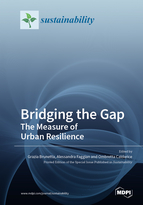Bridging the Gap: The Measure of Urban Resilience
A special issue of Sustainability (ISSN 2071-1050).
Deadline for manuscript submissions: closed (31 October 2020) | Viewed by 63325
Special Issue Editors
Interests: spatial planning; regional development; urban resilience; strategic environmental assessment
Interests: human capital; migration; regional resilience
Interests: urban resilience; spatial planning; urban regulation; land use policy
Special Issue Information
Dear Colleagues,
Over the last few years, resilience has emerged as a “new way of thinking” (Folke, 2016) for dealing with cities’ uncertainties and challenges. As promoted by UN Sustainable Development Goal 11, urban resilience is increasingly seen as a driver for change (Merrow and Newell, 2016) so that planning approaches worldwide are straightening notions of “fluidity, reflexivity, contingency, connectivity, multiplicity and polyvocality” (Davoudi et al., 2013). At the same time, resilience is commonly criticized for being too ambiguous and an “empty signifier” (Wichselgartner and Kelman, 2015) as it is difficult to operationalize it (Vale, 2014). Although several frameworks have been already proposed to “capturing resilience” in both the academic and public discourse, the existing approaches are confined to measure specific disturbances so that less attention has been directed to consider resilience as a continually changing process. In a nutshell, the developed methods of resilient metrics are set indicators of what is easy to measure rather than what is important (Carpenter et al., 2009).
This Special Issue seeks to synthesize the state-of-the-art knowledge on theories and practices on measuring urban resilience. In particular, we are particularly interested in both empirical and theoretical papers that address one or more of the following questions: What are the theoretical perspectives of measuring urban resilience? How can urban resilience a property to be measured? What are the existing models and methods for measuring urban resilience? What are the main features that a method for measuring urban resilience need to have to guide properly adaptation and territorial governance? What is the role of measuring urban resilience in operationalizing cities’ ability to adapt, recover and benefit from shocks? In addition to the submitted peer-review papers related to measuring urban resilience, the Special Issue will also comprise selected papers from the XXXIX Annual Scientific Conference of the Italian Association of Regional Science (https://www.aisre.it/en/annual-scientific-conference/introduction). Authors who presented their papers at the conference will be invited by the Guest Editors to submit their manuscripts to the Special Issue and enter into the peer-review process.
Finally, we are interested in better connecting worldwide researchers to foster collaborations on the theme of “Understanding Urban Resilience”. Therefore, we will involve all the authors to be connected to the research activity of the Responsible Risk Resilience Centre (R3C) of Politecnico di Torino in particular on future perspectives about urban resilience research.
References:
Carpenter S.R., Folke C., Norström A., Olsson O., Schultz L., Agarwal B., et al. (2012) Program on ecosystem change and society: An international research strategy for integrated social-ecological systems. Current Opinion in Environmental Sustainability, 4, 134–138.
Davoudi S., Brooks E., Mehmood, A. (2013) Evolutionary Resilience and Strategies for Climate Adaptation, Planning Practice and Research, 28:3, 307–322.
Folke C. (2016) Resilience, Oxford Research Encyclopedia of Environmental Science, 10.1093/acrefore/9780199389414.013.8.
Meerow S., Newell J.P. (2016) Urban resilience for whom, what, when, where and why? Urban Geography, http://dx.doi.org/10.1080/02723638.2016.1206395.
Vale L.J. (2014) The politics of resilient cities: whose resilience and whose city? Building Research & Information, 42:2, 191-201.
Weichselgartner J., Kelman I. (2015) Geographies of resilience: Challenges and opportunities of a descriptive concept. Progress in Human Geography, 39(3), 249–267.
Prof. Grazia Brunetta
Prof. Alessandra Faggian
Dr. Ombretta Caldarice
Guest Editors
Manuscript Submission Information
Manuscripts should be submitted online at www.mdpi.com by registering and logging in to this website. Once you are registered, click here to go to the submission form. Manuscripts can be submitted until the deadline. All submissions that pass pre-check are peer-reviewed. Accepted papers will be published continuously in the journal (as soon as accepted) and will be listed together on the special issue website. Research articles, review articles as well as short communications are invited. For planned papers, a title and short abstract (about 100 words) can be sent to the Editorial Office for announcement on this website.
Submitted manuscripts should not have been published previously, nor be under consideration for publication elsewhere (except conference proceedings papers). All manuscripts are thoroughly refereed through a single-blind peer-review process. A guide for authors and other relevant information for submission of manuscripts is available on the Instructions for Authors page. Sustainability is an international peer-reviewed open access semimonthly journal published by MDPI.
Please visit the Instructions for Authors page before submitting a manuscript. The Article Processing Charge (APC) for publication in this open access journal is 2400 CHF (Swiss Francs). Submitted papers should be well formatted and use good English. Authors may use MDPI's English editing service prior to publication or during author revisions.
Keywords
- Urban resilience
- Spatial planning
- Quantitative, qualitative and mixed models and methods
- Empirically-based case studies







